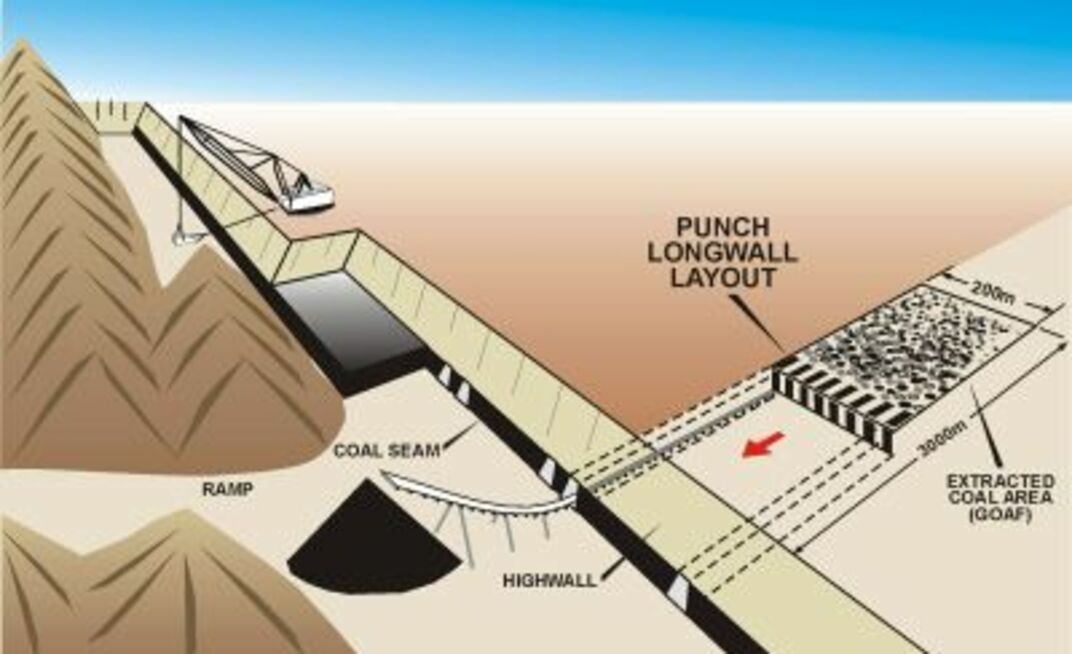With a length of 2900m and 170m of lift, conveyors needed to be relatively long and moderately steep. Coupled with its challenging geometry was the need to integrate much of the maingate conveyor equipment from the significantly different old Kenmare longwall.
The product of these challenges was the use of dynamic analysis modelling as an essential tool in conveyor design. Traditionally, static modelling has been used, but the use of dynamic analysis allowed conditions in a conveyor system to be simulated so potential problems could be dealt with at the design stage – particularly important in the design of high-capacity maingate belts.
Located adjacent to active mining areas of BMA's Goonyella opencut mine lease, Broadmeadow mine will feature BMA's first application of punch longwall mining, with first production expected mid-2005. The $102 million mine will produce up to 3.6 million tonnes per annum of high quality coking coal.
Continental Conveyor and Equipment was awarded the Broadmeadow conveyor contract in 2003. The company was responsible for the design and supply of new equipment for the maingate conveyors, along with the refurbishment of equipment from the old Kenmare mine for the new system.
The Broadmeadow mine coal clearance system consisted of maingate conveyors feeding onto an inpit conveyor that transferred to a ramp conveyor, which lifted the coal from the pit floor and delivered to the 100,000t ROM (run-of-mine) coal stockpile at the surface.
The ramp and inpit conveyors were essentially surface conveyors, while the maingates were positioned with the headends and drives located outside the mine, with the loop take-up and booster drives installed underground.
The Broadmeadow maingates were designed to carry 3500t per hour on a 1500mm wide belt at 4m per second. Located at the headend and at two booster locations were 500kW and 320kW drives using 420K Controlled Start Transmissions (CST).
Continental project manager Keith McQualter said although there were larger capacity systems on the market, the Broadmeadow Mine design was based on optimising the re-use of Kenmare mine equipment. He said other mines with systems of Broadmeadow’s capacity were producing in excess of 5Mtpa with one longwall, the key being consistent production rates.
When designing the system, McQualter said extensive dynamic analysis was carried out to ensure the system forces were limited to the capacity of the equipment and other dynamic issues were adequately controlled.
“These issues included things like runback at the tail, always a problem on long, steep conveyors with a relatively high stretch belt. If this runback is not kept within strict limits, ingestion of material at the boot end can be a real problem,” he said.
Not only was Broadmeadow a challenge with conveyor length and slope, the mine’s punch layout also offered some unique challenges due to the need for carefully designed vertical curves to prevent belt lift-off when passing through the portal entries of the punch layout. Longwall punch mining configurations differ from traditional longwall operations due to the inpit and ramp conveyors being installed in the open air as opposed to an underground trunk and drift conveyors.
The limited trench space and ventilation configuration required the installation of the Maingate 1 conveyor loop take-up inside the portal. As a consequence, the equipment needed to be suitable for operation in an Explosion Risk Zone 1 (ERZ1). Flame-proofed electric motors and intrinsically safe control equipment was required.
Maingate 2 conveyor loop take-up was moved out of the portal away from the ERZ1 to enable the installation of a shortened version during development. Additional loop modules and two booster drives will be added prior to longwall ramp-up.
Continental has also incorporated soft start into the conveyor components through the CST wet clutch, which provided controllable torque transmission from the motor to the pulley. The CST also acts as a gearbox, reducing the motor speed to the conveyor speed. Drive pulleys transferred the applied torque to the belt, resulting in belt movement.
Effective load sharing and control was achieved through disproportionate drive pulley sizes to assist in a master-slave relationship between the primary and secondary drives.
Interaction between the head drive and the booster drives was a function of belt tension sensed at the booster drives.
Assisting with equipment supply for Broadmeadow was Apex Fenner, with its pulley lagging, Falk drive couplings, Continental Conveyor pulleys, ESS belt cleaners, and Ringway Queensland with its electrical support.
Initial supply of maingate equipment was required by late-2004. Revisions to mine layout and portal entry, however, required the reworking of head end structures. The reworked equipment for the Maingate 2 conveyor was delivered to site in February, with installation commencing shortly thereafter.
Upgrading of the Maingate 1 conveyor will take place in June 2005, with the installation of two tripper drives each powered by 500kW and 320kW 420K CST's ready for longwall operation.

























